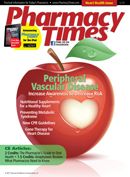Publication
Article
Pharmacy Times
Gene Therapy for Heart Disease
The next evolutionary step for specialty medications could lead to a new generation of cost-effective, noninvasive treatments for heart disease.
The next evolutionary step for specialty medications could lead to a new generation of cost-effective, noninvasive treatments for heart disease.
In previous columns, we focused on specialty medications that mimic or alter current biologic processes within the human body. These types of therapies represent the beginning of a trend toward treatments that work with natural processes to mitigate disease progression and impact. Therefore, it is not surprising that gene therapy represents the next evolutionary step for specialty medications. Gene therapy offers the opportunity to impact disease development or outcomes at the genetic level. Although this type of therapy is still quite early in development, it provides a glimpse of the future for specialty medications.
Heart disease reflects a national and international epidemic as a source of significant morbidity, mortality, and cost. With the average cost of a coronary artery bypass graft (CABG) at $25,140, there is a demand for more cost-effective alternatives to managing the outcomes of heart disease.1 As such, there has been an increase in alternative noninvasive techniques to treat heart disease. One area of current research is the stimulation of angiogenesis within the heart, which would provide a bypassing mechanism for obstructed blood vessels. Stimulation of angiogenesis would effectively increase the collateral blood flow for patients with a cardiac blood flow deficiency.
In a study by Meier et al, patients were evaluated for the impact of naturally occurring excess collateral blood flow within the heart and its overall impact on 10-year mortality and cardiovascularspecific mortality. This analysis showed that patients who had a well-developed collateral blood flow system had an overall mortality rate of 71% and a cardiac mortality rate of 88%, compared with patients who had poorly developed collateral blood flow with values of 89% and 97%, respectively.2
There is 1 agent currently in phase III trials that promotes angiogenesis within cardiac tissue. Under development by Cardium Therapeutics, Generx, also called alferminogene tadenovec (Ad5FGF-4), is a fibroblast growth factor (FGF) that has been shown to stimulate angiogenesis in multiple types of tissues.3 In one of the first published trials examining the impact of FGF, which was derived from genetically modified Escherichia coli, on myocardial tissue of patients undergoing bypass surgery, Schumacher et al found that after 12 weeks of FGF administration, patients demonstrated an increase in the number of myocardial capillaries. The impact of this treatment was localized to the injection site during surgery and clinical outcomes were not evaluated.4
A Novel Method
Although initial trials showed promise, the need to administer FGF protein directly into the heart by surgical technique was concerning because of the invasive nature of the process. The use of gene therapy, whereby a virus is utilized to insert a gene into cells to cause production of the protein, appeared to be a more feasible approach. This novel method involved the intracoronary infusion into the cardiac tissue by means of a catheter.5
In the Angiogenic Gene Therapy (AGENT) trial, patients were given adenovirus vector FGF (Ad5FGF-5) at various doses to determine the impact on exercise tolerance test (ETT) results. The outcome of the study showed a nonsignificant increase in ETT results in patients who received treatment compared with placebo. When patients who had a baseline ETT of greater than 10 minutes were removed, the subgroup analysis showed that ETT times increased significantly. This difference in significance was attributed to the long baseline ETT of some of the patients, which may not demonstrate a change that is sufficient to demonstrate significance.6
In the AGENT-2 study, researchers used nuclear scintigraphy to measure myocardial infusion as opposed to ETT. Eight weeks after treatment with Ad5FGF-4, nuclear scintigraphy showed a significant increase in perfusion for patients receiving active treatment compared with those receiving placebo.7 In the follow-up studies, AGENT-3 and AGENT-4, researchers further evaluated the clinical impact of Ad5FGF-4 on ETT and myocardial perfusion. A total of 532 patients were enrolled in both studies, and inclusion criteria included the ability to exercise for at least 3 minutes and no more than 10 minutes, moderate to severe angina, and a 1-mm ST-segment depression from baseline during their ETT. At weeks 4 and 12, and month 6, there was no significant difference in ETT for the active-treatment groups compared with placebo.
When data were assessed by gender, it was reported that men had no significant difference in ETT; however, women showed a significant increase in ETT time for the 12-month study period. Similar results were shown in ST-segment changes, with only the female group reporting an increase in time to 1-mm ST-segment change. These differences were speculated by researchers to be associated with yet-to-be-discovered gender differences in the angiogenesis process. In response to these results and the potential gender differences in angiogenesis, the manufacturer is currently in the process of developing a study to further evaluate Ad5FGF-4 treatment in women only.
Angiogenesis gene therapy shows promise as a potential treatment for cardiac disease and may serve as an adjunct or alternative to current invasive procedures. The manufacturer of Ad5FGF-4 is currently pursuing to have this agent, once trials are completed, used in industrial countries as second-line therapy after CABG and percutaneous transluminal coronary angioplasty. Within developing countries, which have reduced economic resources, the company is pursuing a primary therapy position. This gene therapy shows the promise of further evolution within the specialty therapeutics market. PT
Dr.Coopermamn is director of research and development and Mr. Allinson is chief executive officer and chief clinical officer of Therigy, LLC.







